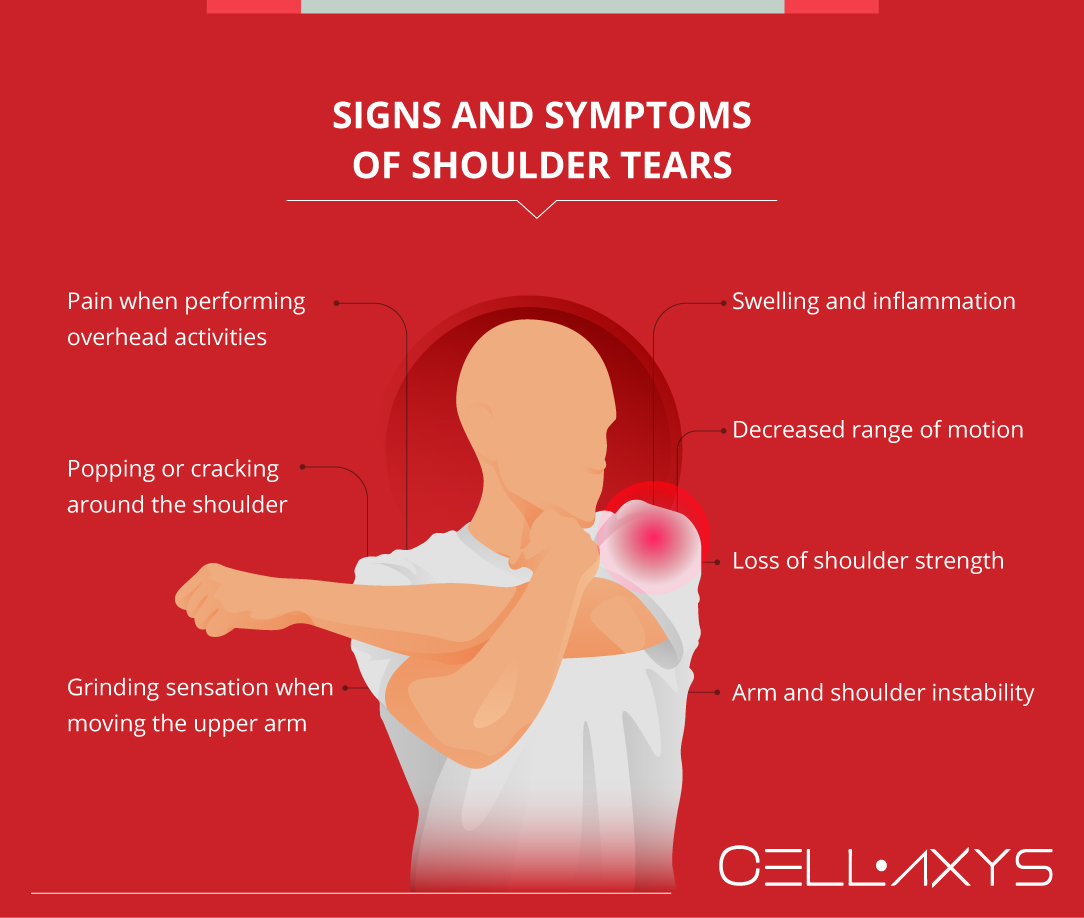Published on: October 2, 2019 | Updated on: August 29, 2024
If you’ve suffered an acute injury to the shoulder it might feel as though it is unstable. The range of motion in your arm may have gone down quite a bit and this may have you worried that the problem may be serious. A shoulder labrum tear is a serious matter and rapid treatment is of the utmost concern.
Understanding the anatomy, signs, and symptoms, and treatment options available after a shoulder labrum tear can help prepare you to make an educated decision and choose the right course of action.
Anatomy of the Shoulder Labrum
The shoulder is a ball-and-socket joint composed of the upper head of the humerus (ball) and a pocket-shaped bone known as the glenoid (socket). Between the meeting point of these bones lies the labrum – a band of fibrocartilaginous tissue that helps to nest the ball of the upper arm bone within the shallow socket formed by the glenoid.
The labrum deepens the pocket formed by the glenoid and provides stability to arm movements by providing a smooth rim around which the head of the humerus can move. Additionally, the labrum helps to prevent injury to the cartilage which surrounds the head of the humerus and cavity of the glenoid.
Labral tears are tiny rips in the structure of the labrum. Over time, prolonged or excessive use of the arm exacerbates these tears, increasing their size and eventually causing problems in the function of the shoulder and arm.
Signs and Symptoms of Shoulder Tears

Signs for any shoulder injury will be relatively similar. These include:
- Pain when performing overhead activities
- Popping or cracking around the shoulder
- Grinding sensation when moving the upper arm
- Swelling and inflammation
- Decreased range of motion
- Loss of shoulder strength
- Arm and shoulder instability
The sign to be especially wary of if you believe you’ve suffered a tear to the labrum is instability. The labrum helps provide a guide for the “ball” of the upper arm bone to move within the glenoidal pocket. Thus, unstable or unsmooth arm function can be a strong indication of a tear in the foundation of the labrum.
Causes and Risk Factors
Typically, labral tears form after an acute injury. Blunt trauma, especially that which involves hyperextension of the upper arm and shoulder, is an especially common cause of a labral tear. Other causes and risk factors may be:
- The repetitive motion of the upper arm
- Extended periods of upper arm strain
- Falls on outstretched arms
- The sudden jerk of the arm
Labral tears usually occur during rapid-onset incidents or after extended periods of upper arm strain.
Diagnosis of Shoulder Labrum Tears
Depending on the location of the tear, it will be diagnosed as one of 3 distinct types:
SLAP tears or lesions
SLAP is short for “superior labrum, anterior to posterior” which means that the injury goes from the front of the shoulder to the back. A tear in the shoulder labrum is dubbed SLAP if it is above the center of the glenoid. Damage to the bicep tendon as well as commonly performing overhead motions are risk factors for this type of injury.
Bankart tears or lesions
When the tear is localized to the bottom portion of the glenoid socket, this is known as a Bankart tear in the labrum. Chronic dislocation of the shoulder puts an individual at a higher risk of developing this type of tear.
Posterior labrum tears
If pain is restricted to the back of the shoulder joint, these types of labral tears are referred to as posterior labrum tears. These types of tears are rare due to the restricted motion of the arm towards the back of an individual’s body.
While the 3 types of shoulder labrum tears are distinct, their symptoms will be relatively the same. As these symptoms progress into a chronic issue, they may become debilitating. If this is the case, it may be time to schedule a medical intervention.
Conventional Treatments
There is a wide variety of treatment options available to those who have suffered a labral tear. The following conventional treatment options are the most highly recommended and widely accepted solutions to the problems a labral tear may cause.
Physical therapy
A typical recovery plan will include some form of physical therapy. These therapies are aimed at relieving pain, decreasing swelling, and increasing range of motion through physical means such as massage, hot/cold therapy, guided stretches, or exercise.
A patient may find that a combination of a few of these therapies can help them reach their functional goals. If not, physical therapy will then be combined with one of the other options listed.
Medication
A medicinal regimen for shoulder labrum tears will focus on increasing blood flow and decreasing swelling in the shoulder. Over-the-counter medications will typically be the first line of defense. Ibuprofen, acetaminophen, and naproxen are some of the medications a doctor will recommend.
Topical balms may be used in conjunction with these medications to quell soreness and stiffness. If these regimens don’t provide enough relief for a few weeks, a doctor may prescribe higher dosages of the same medications or may move on to stronger drugs to relieve the pain.
Steroidal injections
Similar to medication, steroidal injections help to reduce pain by decreasing swelling around the shoulder. As the shoulder swells to cushion the effects of a torn labrum, the nerves within the shoulder get pinched.
As the nerves become more and more compressed, an individual will begin to feel their pain gradually increase. Steroid injections provide relief by reducing the body’s natural response to tear-related symptoms.
It is noteworthy to understand that while steroid injections can help in many cases, this treatment option does come with its own set of dangers. Steroids have been shown to break down the foundation of several tissues throughout the human body with prolonged use. As these tissues break down, the treatment may end up causing more damage to the shoulder than it’s worth.
Surgery
Surgical intervention is typically the last option patients want to consider, especially for labral tears. Not only are the recovery periods long, but the procedures can be very expensive. While surgery may help to relieve some of the pain, it may not achieve the patient’s functional goals post-op.
Conventional treatments are not the only options available to those suffering from a labral tear in the shoulder, they are simply the most commonly prescribed. The potential issues and the need for pain medication post-operation may leave patients unsatisfied.
If these methods and their side effects are not in-tune with a patient’s lifestyle and functional goals, there are alternatives.
Regenerative Therapy for Shoulder Labrum Tears
Regenerative therapy is the name given to a set of injections that may help to reconstruct damaged tissues. The therapies themselves are very simple.
First, tissues are extracted from the patient. Next, these tissues are processed to isolate the active ingredients, which are reinjected into the injury site using special imaging technologies.
At CELLAXYS, we perform two types of regenerative therapy:
Platelet-rich plasma (PRP) therapy
PRP therapy isolates platelets from the patient’s blood plasma, processes them, and then reinjects them into the injury site. Platelets are the healing components in our body that form clots when they sense an injury. They release 10 Growth Factors to stimulate the growth of new tissues and send chemical signals to the body to engage its healing factors and draw them towards their location.
Platelets also produce a sticky, web-like structure called fibrin that serves as the scaffolding for developing new tissues. Increasing platelets in the injury site amplify the body’s natural reaction to injury and reconstruct damaged tissues faster.
PRP is a popular treatment for orthopedic, spine, and sports injuries. It takes about 45 minutes to complete.
Cell-based therapies
Also known as stem cell therapies, these therapies extract healthy cells from the patient’s body and reinject them into the injury site. The doctor is likely to opt for one of the two types of cell-based therapies, including:
- Minimally Manipulated Adipose Tissue (MMAT) Transplant. This procedure is highly effective in treating shoulder labrum tears. The doctors replace the damaged cells with healthy cells from your adipose (fat) tissue. If your shoulder needs MMAT in multiple locations, the doctor will perform all of them in the same procedure.
- Bone Marrow Concentrate (BMAC). This procedure replaces damaged cells with highly concentrated cells from your bone marrow.
For both cell-based procedures, the doctor will put you under anesthesia for your comfort. MMAT and BMAC take about 1.5-2 hours to complete.
Doctors use a live X-ray (fluoroscopy) or ultrasound for all transplant locations to ensure the exact spot. Cell-based and PRP therapies are outpatient procedures, meaning you go home after the procedure.
Each of these therapies amplifies the other’s reaction to an injury when used in unison. Not only do they treat the pain caused by the injury, but they also treat the underlying cause of it, thereby providing longer-lasting results than conventional treatment options.
Sources
Footnotes
- Keener JD, Brophy RH. Superior labral tears of the shoulder: pathogenesis, evaluation, and treatment. JAAOS-Journal of the American Academy of Orthopaedic Surgeons. 2009;17(10):627-37.
- Nam EK, Snyder SJ. The diagnosis and treatment of superior labrum, anterior and posterior (SLAP) lesions. The American journal of sports medicine. 2003;31(5):798-810.
- Aydin N, Sirin E, Arya A. Superior labrum anterior to posterior lesions of the shoulder: diagnosis and arthroscopic management. World journal of orthopedics. 2014;5(3):344.
- Matsuki K, Sugaya H. Complications after arthroscopic labral repair for shoulder instability. Current reviews in musculoskeletal medicine. 2015 Mar;8:53-8.
- Pountos I, Panteli M, Walters G, Bush D, Giannoudis PV. Safety of epidural corticosteroid injections. Drugs in R&D. 2016;16:19-34.
References
- Shoulder Labrum Tear. Johns Hopkins Medicine. Accessed 2/23/2024.
- Labral Tears of the Shoulder Diagnosis and Treatment. Penn Medicine. Accessed 2/23/2024.
- Labral Tears in the Shoulder or Hip. UPMC. Accessed 2/23/2024.
- SLAP Tears. OrthoInfo. Accessed 2/23/2024.
CELLAXYS does not offer Stem Cell Therapy as a cure for any medical condition. No statements or treatments presented by Cellaxys have been evaluated or approved by the Food and Drug Administration (FDA). This site contains no medical advice. All statements and opinions are provided for educational and informational purposes only.
Dr Pouya Mohajer
Author
Pouya Mohajer, M.D. is the Director of Spine and Interventional Medicine for CELLAXYS: Age, Regenerative, and Interventional Medicine Centers. He has over 20 years of experience in pain management, perioperative medicine, and anesthesiology. Dr. Mohajer founded and is the Medical Director of Southern Nevada Pain Specialists and PRIMMED Clinics. He has dedicated his career to surgical innovation and scientific advancement. More about the doctor on this page.
Dr Pejman Bady
Contributor
Dr. Pejman Bady began his career over 20 years ago in Family/Emergency Medicine, working in fast-paced emergency departments in Nevada and Kansas. He has served the people of Las Vegas as a physician for over two decades. Throughout this time, he has been met with much acclaim and is now the head of Emergency Medical Services in Nye County, Nevada. More about the doctor on this page.









